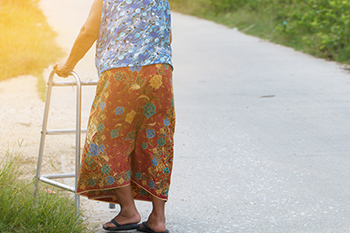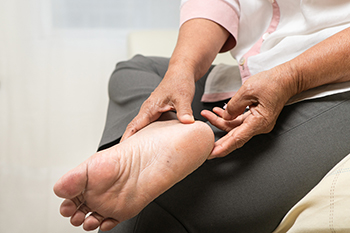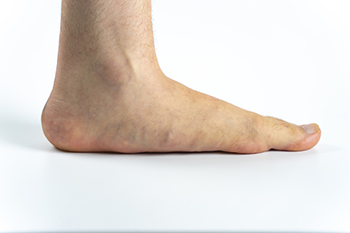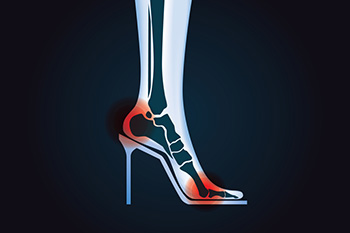Items filtered by date: October 2022
Can Falls Be Prevented?

Falling among the elderly can invoke a horrible fear to the extent that one may decide to limit their daily activities. This can negatively affect one’s quality of life and leave them socially isolated. Upon falling, many endure serious physical injuries that include the feet, making it difficult to walk. There are measures that can be implemented that may help to protect one from falling. These can include removing frayed rugs from the living environment, improving lighting in the household, and wearing shoes that fit correctly. Additionally, it is beneficial to install grab bars in the shower and toilet area, as well as use bath mats that can help to avoid slipping. Engaging in a gentle exercise program can help to strengthen the overall body and this is essential in falls prevention. If you have questions about additional methods that can prevent falling and the potential harm falling can have on the feet, please contact a podiatrist.
Preventing falls among the elderly is very important. If you are older and have fallen or fear that you are prone to falling, consult with Leonora Fihman, DPM from California. Our doctor will assess your condition and provide you with quality advice and care.
Every 11 seconds, an elderly American is being treated in an emergency room for a fall related injury. Falls are the leading cause of head and hip injuries for those 65 and older. Due to decreases in strength, balance, senses, and lack of awareness, elderly persons are very susceptible to falling. Thankfully, there are a number of things older persons can do to prevent falls.
How to Prevent Falls
Some effective methods that older persons can do to prevent falls include:
- Enrolling in strength and balance exercise program to increase balance and strength
- Periodically having your sight and hearing checked
- Discuss any medications you have with a doctor to see if it increases the risk of falling
- Clearing the house of falling hazards and installing devices like grab bars and railings
- Utilizing a walker or cane
- Wearing shoes that provide good support and cushioning
- Talking to family members about falling and increasing awareness
Falling can be a traumatic and embarrassing experience for elderly persons; this can make them less willing to leave the house, and less willing to talk to someone about their fears of falling. Doing such things, however, will increase the likelihood of tripping or losing one’s balance. Knowing the causes of falling and how to prevent them is the best way to mitigate the risk of serious injury.
If you have any questions, please feel free to contact our offices located in Encino and Brentwood, Los Angeles, CA . We offer the newest diagnostic and treatment technologies for all your foot care needs.
Causes of Numbness in the Feet

Sometimes when you sit for a while with legs crossed, a feeling of numbness and tingling in the feet sets in, but dissipates rapidly after standing up or changing positions. The term for this sensation is transient (temporary) paresthesia. Frequent or long term numbness, however, can indicate more serious problems and could be caused by an underlying medical condition, such as diabetes or peripheral artery disease. Other possible causes of numbness in the feet include an injury that puts pressure on the nerves, lower back problems, or sciatica (irritation of the sciatic nerve). Tarsal tunnel syndrome, when a nerve that runs from the back of leg to the ankle and foot is compressed or damaged, also can result in numbness. Tumors or growths that put pressure on the spinal cord, legs or feet may be another cause. Numbness is often joined by tingling, pain, and a burning or itching sensation. If you are experiencing any of these symptoms regularly, it is a good idea to consult a podiatrist who can determine the cause and suggest an appropriate treatment plan.
Everyday foot care is very important to prevent infection and other foot ailments. If you need your feet checked, contact Leonora Fihman, DPM from California. Our doctor can provide the care you need to keep you pain-free and on your feet.
Everyday Foot Care
Often, people take care of their bodies, face and hair more so than they do for their feet. But the feet are a very important aspect of our bodies, and one that we should pay more attention to. Without our feet, we would not be able to perform most daily tasks.
It is best to check your feet regularly to make sure there are no new bruises or cuts that you may not have noticed before. For dry feet, moisturizer can easily be a remedy and can be applied as often as necessary to the affected areas. Wearing shoes that fit well can also help you maintain good foot health, as well as making it easier to walk and do daily activities without the stress or pain of ill-fitting shoes, high heels, or even flip flops. Wearing clean socks with closed shoes is important to ensure that sweat and bacteria do not accumulate within the shoe. Clean socks help to prevent Athlete’s foot, fungi problems, bad odors, and can absorb sweat.
If you have any questions please feel free to contact our offices located in Encino and Brentwood, Los Angeles, CA . We offer the newest diagnostic and treatment technologies for all your foot and ankle needs.
Living With Flat Feet

When a person has flat feet, it means that the longitudinal arch of the foot, which runs along the sole of the foot, has failed to develop properly or has collapsed. It can affect one or both feet, depending on the cause. Children are generally born with flat feet, but the arch normally develops by the time they reach 5 years of age. Flat feet may be inherited or caused by an injury. They also may be the result of an underlying medical condition, such as rheumatoid arthritis, stroke, or diabetes. Most people do not experience pain from having flat feet, but fatigue is often a symptom. Surgery is rarely necessary. A number of exercises can help to strengthen the feet. Two common treatments for flat feet are wearing shoes that offer good arch support and having orthotic devices inserted in your shoes. For help in dealing with flat feet, or to order custom orthotics, please visit with a podiatrist.
Flatfoot is a condition many people suffer from. If you have flat feet, contact Leonora Fihman, DPM from California. Our doctor will treat your foot and ankle needs.
What Are Flat Feet?
Flatfoot is a condition in which the arch of the foot is depressed and the sole of the foot is almost completely in contact with the ground. About 20-30% of the population generally has flat feet because their arches never formed during growth.
Conditions & Problems:
Having flat feet makes it difficult to run or walk because of the stress placed on the ankles.
Alignment – The general alignment of your legs can be disrupted, because the ankles move inward which can cause major discomfort.
Knees – If you have complications with your knees, flat feet can be a contributor to arthritis in that area.
Symptoms
- Pain around the heel or arch area
- Trouble standing on the tip toe
- Swelling around the inside of the ankle
- Flat look to one or both feet
- Having your shoes feel uneven when worn
Treatment
If you are experiencing pain and stress on the foot you may weaken the posterior tibial tendon, which runs around the inside of the ankle.
If you have any questions please feel free to contact our offices located in Encino and Brentwood, Los Angeles, CA . We offer the newest diagnostic and treatment technologies for all your foot and ankle needs.
High Heels Can Affect the Feet and Ankles

Research has shown that the shoes women wear, specifically high heels and sandals, are major contributors to heel and ankle pain. The best way to avoid a future of painful feet is to avoid these types of shoes early in life. Opting instead for sneakers or athletic footwear that provide the proper cushioning and support for the feet, heels and ankles is recommended. With every step you take, a significant amount of force is transmitted to the ankles, heels, and feet. Without the proper support or protection, these areas are put at risk for injury. Improper footwear can also contribute to toe problems, including bunions, calluses, corns, and hammertoes. Choosing comfort over style is suggested as a way to avoid painful problems later in life. Other recommendations are to wear shoes that conform to the shape of your foot, avoid shoes with pointed or tapered toes, and buy shoes that fit well – regardless of the size on the box. For more information on the risks of wearing high heels, or for help with any painful foot and ankle conditions you may have, please visit a podiatrist.
High heels have a history of causing foot and ankle problems. If you have any concerns about your feet or ankles, contact Leonora Fihman, DPM from California. Our doctor can provide the care you need to keep you pain-free and on your feet.
Effects of High Heels on the Feet
High heels are popular shoes among women because of their many styles and societal appeal. Despite this, high heels can still cause many health problems if worn too frequently.
Which Parts of My Body Will Be Affected by High Heels?
- Ankle Joints
- Achilles Tendon – May shorten and stiffen with prolonged wear
- Balls of the Feet
- Knees – Heels cause the knees to bend constantly, creating stress on them
- Back – They decrease the spine’s ability to absorb shock, which may lead to back pain. The vertebrae of the lower back may compress.
What Kinds of Foot Problems Can Develop from Wearing High Heels?
- Corns
- Calluses
- Hammertoe
- Bunions
- Morton’s Neuroma
- Plantar Fasciitis
How Can I Still Wear High Heels and Maintain Foot Health?
If you want to wear high heeled shoes, make sure that you are not wearing them every day, as this will help prevent long term physical problems. Try wearing thicker heels as opposed to stilettos to distribute weight more evenly across the feet. Always make sure you are wearing the proper shoes for the right occasion, such as sneakers for exercising. If you walk to work, try carrying your heels with you and changing into them once you arrive at work. Adding inserts to your heels can help cushion your feet and absorb shock. Full foot inserts or metatarsal pads are available.
If you have any questions please feel free to contact our offices located in Encino and Brentwood, Los Angeles, CA . We offer the newest diagnostic and treatment technologies for all your foot and ankle needs.

